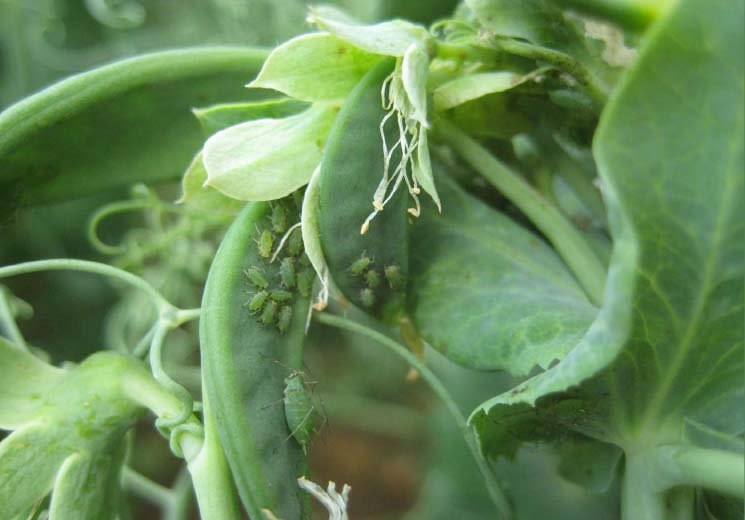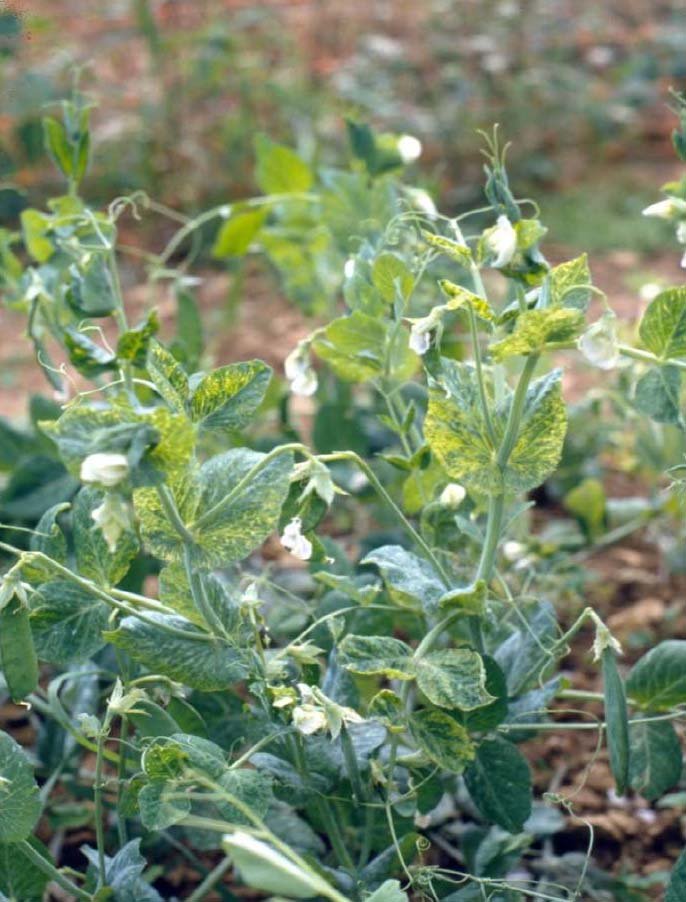 Full
FullGuide »

March 2025
Pea aphid
Attacks by aphids may result in loss of yield by spoiling flowers, causing failure of pods to fill and by generally reducing plant efficiency. Aphids transmit viruses and produce honeydew, an ideal medium for colonisation by saprophytic fungi, in particular the sooty moulds. In addition, honeydew is very sticky and can lead to increased costs through the necessity of more frequent washing down of vining machinery.
DESCRIPTION AND LIFE HISTORY
The pea aphid (Acyrthosiphon pisum) is green in colour with a pear-shaped body, long legs, and long antennae. There are both winged and wingless forms, the winged females being 2.5 – 3.0 mm long with deep red or black eyes, while the wingless females are of similar form but have a smooth, shiny outer skin.
Colonies are formed quickly, smothering the plant, as the female needs no male for fertilisation(parthenogenesis), and bears living young (viviparous) at a rate of 15 per day in suitable conditions.There are several generations in the pea aphid life cycle. Eggs over-winter on forage crops such as lucerne and clover, hatching in the spring to give wingless stem mothers. These produce spring colonies of wingless females, which in turn produce winged females that move into the crop in summer. These migrants produce the colonies that damage the crop. As the pea plants deteriorate the colonies producewinged female migrants that move to other plants to produce new colonies. Later in the season wingedfemales move to over-wintering host plants where they produce males and females that lay eggs onthe winter hosts.
CONTROL
Losses due to aphids can be varied and considerable. If there is a light but general distribution in humid weather, or if breeding colonies are evident, then control measures are generally warranted. The thresholds for treatment of pea aphid to prevent feeding damage areas follows: spray combining peas when 20% of plants are infested and vining peas when 15% of plants are infested. Always check labels for harvest intervals. The choice of product should be made with consideration of any other pests that are present at the time, such as pea midge and pea moth.
Timing of application can also affect the degree of virus infection as well as yield loss. In the case of pea seed-borne mosaic virus and pea enation mosaic virus aphids should be controlled as soon ascolonies appear, particularly if this occurs before flowering. Where aphid infestation occurs late in the growing season yield increases from aphicides can be obtained in combining peas up to the development of the fourth pod-bearing node. Where infestation occurs after this point there is no appreciable yield loss. The Rothamsted Insect Survey (https://insectsurvey.com/aphid-bulletin)provides information about aphid flights throughout the season and is a useful tool to help predict activity in crops.

VIRUS DISEASES
Pea seed-borne mosaic virus (PSbMV)
The virus is primarily seed-borne but is transmitted by several aphids including the pea aphid, black bean aphid and peach-potato aphid. The virus becomes established after using infected seed and is transmitted by winged aphids early in the spring. Symptoms include vein-clearing, narrowing and downward rolling of leaflets and foreshortening of the apical internodes. Pods at the upper part of the plants may be stunted and appear to have a glossy green appearance. As the peas mature inside the pod a white blistering may develop giving the peas a ‘tennis-ball’ marking over the seed coat.
The virus affects quality in vining peas, and it is important to maintain disease-free seed stocks. PSbMV can be detected in seed using an ELISA (enzyme linked immunosorbent assay) test, although not all infected seeds give rise to infected seedlings.
Pea enation mosaic virus (PEMV)
The presence of this disease is seldom noticed before the approach of flowering, and often not until much later. PEMV is aphid transmitted and is likely to have a greater effect on the crop if transmitted before flowering occurs. PEMV causes vein clearing and the formation of translucent spots which are apparent when infected leaves are held up to the light. Development of stipules is often retarded, and they remain very narrow. Leaflets are crinkled and necrotic spots may appear. Often the tops of the plants become yellow and mottled with distorted leaves. Pods may be severely malformed and fail to fill. The appearance of enations, small, irregular, protruding ridges of plant tissue which are found onthe under sides of leaves and on pods, indicates an advanced stage of infection. Terminal growth ceases, axillary buds disappear, and flower set is impaired. In severe cases yield is greatly reduced. Efficient control of aphids reduces the risk of losses.
In 2019 and 2021 a survey carried out by PGRO and FERA Science Ltd., funded by AHDB, identified turnip yellows virus (TuYV) in peas in the UK.

Turnip yellows Virus (TuYV)
Turnip yellows virus is known to be present in the UK and causes high yield loss in oil seed rape. This was the most prevalent virus found in a survey of pea crops between 2019 and 2022 (AHDB,FV459). It has been reported in peas in Germany and Australia and has a wide host range, including brassicas and legumes. Stunting and yellowing have been previously associated with TuYV infection, however specific yield loss studies have not observed symptoms associated with TuYV infection, and symptoms have not been observed in UK peas. Despite lack of symptoms, up to 40% yield losses can be caused by TuYV. The work conducted between 2019 and 2022 indicated that existing farm practice for control of aphid vectors mitigated the yield impact of TuYV in peas. TuYV is persistently transmitted by aphids, and it is not known to be transmitted by seeds or mechanically. The current resistance status of pea varieties in the UK is not known.